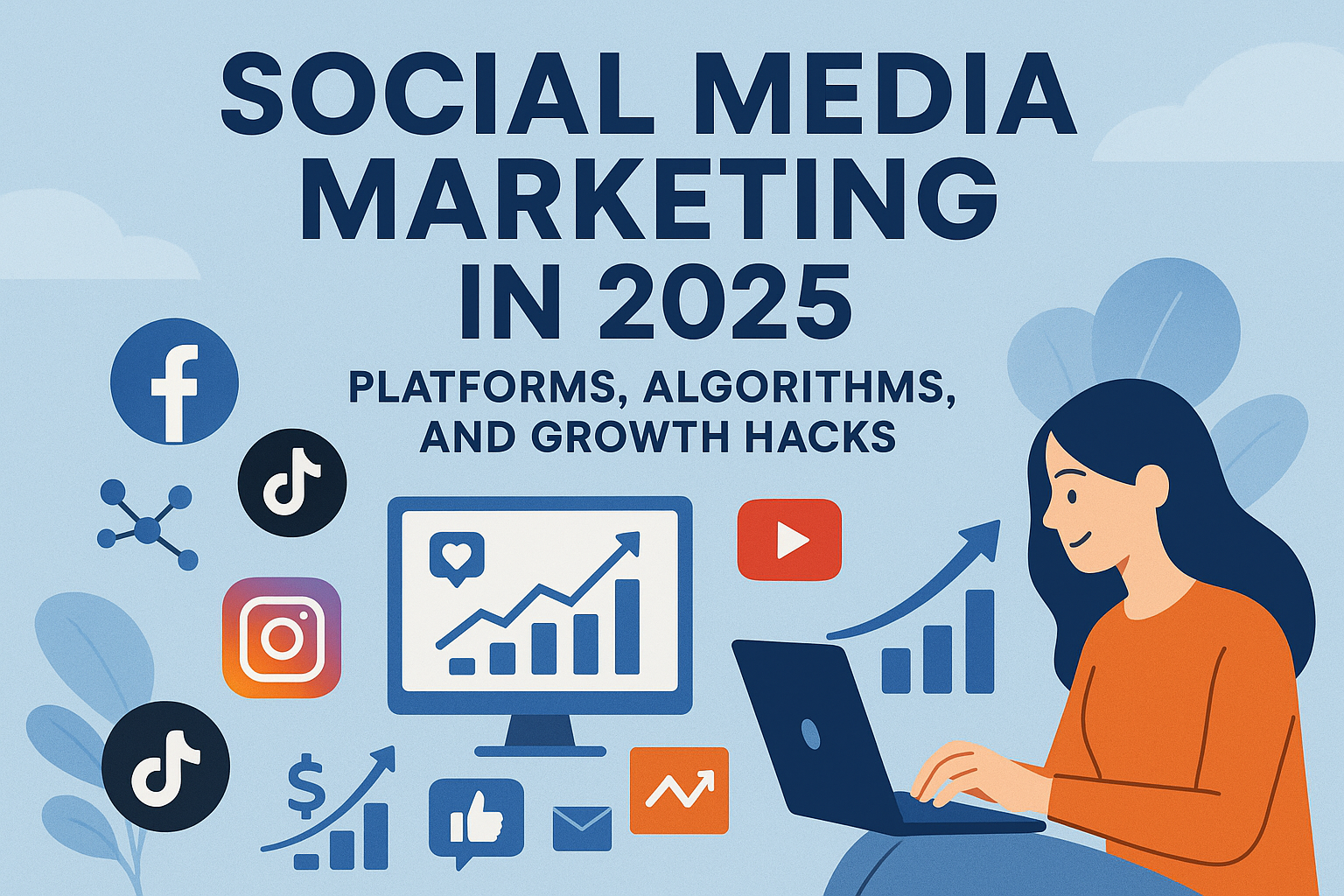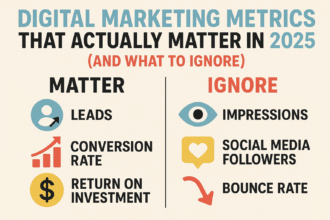Social Media Marketing in 2025: Platforms, Algorithms, and Growth Hacks
Social media marketing in 2025 has reached a pivotal moment. With over 5 billion active users worldwide, platforms continue to evolve rapidly, driven by AI, new consumer behaviors, and algorithmic shifts. For businesses, creators, and marketers, staying ahead means mastering not only the platforms themselves but also the algorithms that determine visibility and reach. In this comprehensive guide, we’ll explore the current state of social media marketing, emerging platform trends, algorithm updates, and practical growth hacks that work in 2025.
Why Social Media Marketing in 2025 Matters
Digital platforms are no longer just spaces for entertainment; they are full-fledged ecosystems for commerce, branding, and community building. According to Statista, global ad spending on social platforms surpassed $250 billion in 2024, and this figure is projected to grow steadily through 2025. For brands, ignoring social media means losing relevance, while leveraging it effectively can drive measurable ROI.
- Consumer shift: 75% of Gen Z and Millennials rely on social platforms for product discovery.
- AI-powered recommendations: Algorithms prioritize content relevance, personalization, and engagement.
- Commerce integration: Social shopping features have transformed platforms into digital malls.
Top Social Media Platforms in 2025
1. TikTok and Short-Form Video Dominance
TikTok remains the most influential platform in 2025, with over 1.8 billion monthly active users. Its algorithm continues to focus on hyper-personalization, making it an ideal platform for virality. Short-form video content (15–60 seconds) is still king, but TikTok now integrates live commerce and AI-driven content recommendations to boost engagement and conversions.
2. Instagram’s Transformation
Instagram has evolved into a hybrid platform balancing social interaction, creator tools, and e-commerce. Reels remain its fastest-growing feature, but Instagram Shops and AI-recommended product feeds are central to its 2025 strategy. Authenticity-driven features, like “Close Friends Broadcasts,” help brands create exclusive communities.
3. YouTube’s Long-Form + Shorts Ecosystem
YouTube continues to dominate long-form content while aggressively expanding Shorts. With over 3 billion searches monthly, it acts as both a search engine and a social platform. YouTube’s AI-driven recommendation engine remains one of the most advanced, rewarding consistent creators with visibility and monetization opportunities.
4. LinkedIn for B2B Growth
In 2025, LinkedIn has fully embraced AI-driven professional networking. Content engagement is rising, especially in thought leadership, industry insights, and career branding. For B2B marketers, LinkedIn is the go-to platform for lead generation and authority building.
5. Emerging Platforms
Decentralized networks and niche communities are on the rise. Platforms like BeReal 2.0 and Web3-integrated apps allow users to control data while fostering authentic interactions. Brands experimenting early here are gaining a competitive edge.
Understanding Social Media Algorithms in 2025
The AI-First Algorithm Shift
Algorithms in 2025 prioritize personalization, predictive engagement, and contextual relevance. AI evaluates not just clicks and likes, but viewing time, sentiment analysis, and shareability to determine reach.
Platform-Specific Algorithm Updates
- TikTok: Rewards high completion rates and early engagement.
- Instagram: Prioritizes original content, community interactions, and relevance signals over reposts.
- YouTube: Focuses on retention, binge-worthy playlists, and keyword-rich metadata.
- LinkedIn: Amplifies niche expertise, thought leadership, and conversations in comments.
Impact of AI Moderation
Platforms now use AI to detect misinformation, spam, and harmful content in real-time. This means authenticity, transparency, and value-driven content are rewarded over clickbait.
Proven Growth Hacks for Social Media in 2025
1. Micro-Communities and Private Groups
Brands are increasingly using private groups (Discord, Telegram, LinkedIn Groups) to foster loyalty and exclusivity. These micro-communities create deeper engagement than broad public posts.
2. AI-Powered Content Creation
Marketers are leveraging AI tools for video editing, caption generation, and audience insights. However, human creativity and storytelling remain crucial for standing out.
3. Social SEO
With AI assistants and voice search growing, optimizing posts with conversational keywords and structured data is critical. For example, including FAQs in captions boosts discoverability on AI-driven search engines like Perplexity and ChatGPT plugins.
4. Cross-Platform Storytelling
Repurposing content across formats—Reels, Shorts, LinkedIn carousels—maximizes reach. Brands using cohesive storytelling across channels see higher conversion rates.
5. Live Commerce and Shoppable Content
Live-streamed product launches and interactive shopping experiences are driving billions in revenue. In China, live commerce already accounts for 20% of e-commerce, and Western markets are catching up fast.
Case Studies
Case Study 1: Nike’s TikTok Micro-Campaign
Nike launched a TikTok challenge in 2025 leveraging user-generated content. With just $100K in paid promotion, the campaign generated 500M+ organic views and a 20% sales lift in targeted demographics.
Case Study 2: HubSpot’s LinkedIn Growth Strategy
HubSpot doubled its B2B leads by focusing on thought leadership posts and employee advocacy. By empowering staff to share expertise, they reached niche decision-makers and strengthened brand authority.
Future Trends in Social Media Marketing
- AI Co-Creation: Brands collaborating with AI influencers and avatars.
- AR/VR Integration: Immersive social experiences in metaverse-like environments.
- Privacy-First Marketing: Greater emphasis on data transparency and user trust.
- Subscription Models: Creators and brands offering exclusive paid content on mainstream platforms.
Conclusion
Social media marketing in 2025 is defined by constant change, AI-powered personalization, and community-driven growth. To succeed, brands must adapt to new algorithms, embrace emerging platforms, and use data-driven yet authentic strategies. Whether you’re a global enterprise or a small startup, leveraging the right growth hacks will ensure visibility and sustainable growth in the digital era.
FAQ: Social Media Marketing in 2025
1. What is the most important platform for marketing in 2025?
TikTok continues to dominate consumer attention, especially for younger demographics. However, YouTube and LinkedIn remain crucial for long-form content and B2B marketing respectively. Brands should adopt a multi-platform strategy for maximum impact.
2. How have algorithms changed in 2025?
Algorithms now emphasize personalization, retention, and value. AI analyzes user behavior, sentiment, and engagement depth. This shift rewards content that is authentic, engaging, and aligned with user intent.
3. What growth hacks work best in 2025?
Key growth hacks include leveraging micro-communities, using AI tools for content optimization, adopting social SEO strategies, and experimenting with live commerce. Cross-platform storytelling also plays a major role in expanding reach.
4. How can small businesses compete on social media in 2025?
Small businesses can compete by focusing on niche communities, authentic storytelling, and leveraging AI-powered tools for cost-efficient marketing. Engaging with micro-influencers and prioritizing customer experience are also effective strategies.
5. What is the future of social media marketing beyond 2025?
The future points to deeper integration with AR/VR, AI-driven influencers, and privacy-first advertising models. As platforms evolve, businesses must stay agile and adopt strategies that align with emerging consumer behaviors and technologies.
References:
- Statista. “Global Social Media Ad Spending 2024-2025.”
- Hootsuite. “Social Media Trends 2025 Report.”
- Pew Research Center. “Digital Behaviors and Social Media Use 2025.”








